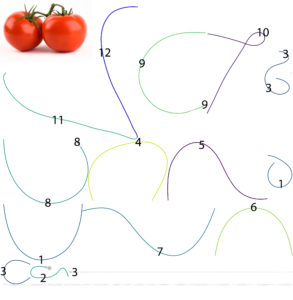KeyGene's impact
Telomere-to-telomere crop genomes using only one DNA sequencing platform

A collaboration between KeyGene scientists and the Telomere to Telomere consortium, which is studying the human genome, has resulted in telomere-to-telomere crop genomes of tomato and maize, using one sequencing technology.
This shows that revealing and understanding genetic variationthroughinnovation in DNA & RNA technology, to improve plant breeding is now getting really ‘easy’. The breakthrough has been shared at different international podia, one of which can now be (re)viewed online.
From 2 to 1 sequencing platform
In March 2022, the complete sequence of a human genome was published. This milestone achievement was made possible by combining long, accurate PacBio HiFi reads with ultra-long Oxford Nanopore reads in combination with advancements in computational algorithms. This recipe for “telomere-to-telomere” (T2T) genome assembly relies on sequencing data from two different platforms, limiting its adoption. Recently, Oxford Nanopore released an end-to-end workflow for telomere-to-telomere human genome sequencing using only the Oxford Nanopore PromethION device.
To test the ability of a single platform to produce T2T crop genome assemblies, KeyGene researchers generated Oxford Nanopore sequencing data for two important crop species: maize and tomato. For each genome, we generated both Oxford Nanopore duplex and simplex sequencing reads. Duplex reads comprise high-quality consensus reads from DNA strands that are read twice, once from the template strand and once from the reverse-complement strand. Simplex sequences are only read once.
Human genome consortium
KeyGene teamed up with the Telomere-to-Telomere consortium to generate gapless genome assemblies with these Oxford Nanopore duplex/simplex sequencing reads and compared that to assemblies that were earlier produced using HiFi data. In particular, we were interested in comparing the hard-to-sequence genomic regions, to better characterize sequence context dependencies in both technologies.
Tomato
In the case of the tomato (Solanum lycopersicum Heinz 1706) data analysis, the Verkko assembler was able to generate a complete, telomere-to-telomere genome assembly with only one gap after a few manual interventions. The gap corresponded to the highly repetitive rDNA region. Verkko took advantage of the duplex data quality, which is similar to PacBio HiFi quality, but tens of kilobases longer. This allowed for a very high-quality initial assembly graph to be constructed from the duplex data, which was then further resolved using the ultra-long simplex reads. The final assembly shows a base accuracy exceeding 99.999% (Q50).
Oxford Nanopore duplex sequencing reads are thus a viable substitute for PacBio HiFi reads, and, in combination with simplex sequencing, have the potential to provide a single-instrument solution for (near) complete genome assembly in a fast and cost-effective way.
Results shared
This breakthrough has been/will be presented on several occasions, by both the Telomere to Telomere consortium and by KeyGene. Sergey Koren of the Telomere to Telomere consortium at the AGBT AG meeting at the end of March in Texas, USA, and the Oxford Nanopore Technologies London Calling conference in May.
KeyGene’s Alexander Wittenberg presented the results in his contribution to the Knowledge Exchange webinar of Oxford Nanopore Technologies in April 2023.
More information
- The results were published in an open access article in Genome Research in November 2024
- Watch the ONT Knowledge Exchange webinar of 20th April 2023
- Learn more about KeyGene’s technology innovation in DNA & RNA technology
- Read more about the perspectives of KeyGene’s support in revealing and understanding genetic variation at hand
Would you like to learn more about the perspectives of telomere-to-telomere genomes?
Use the form to contact us!